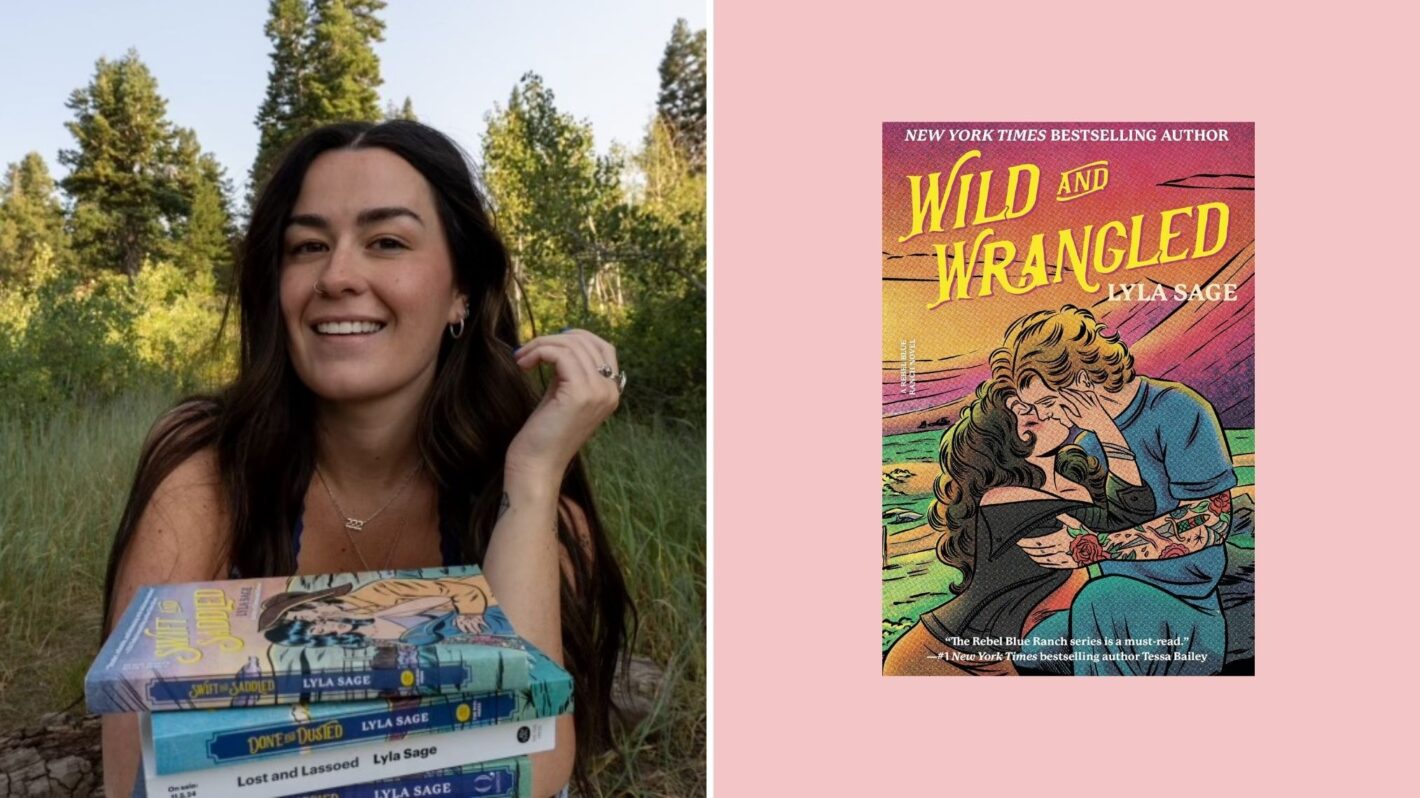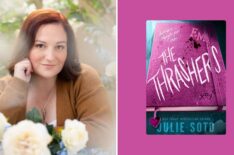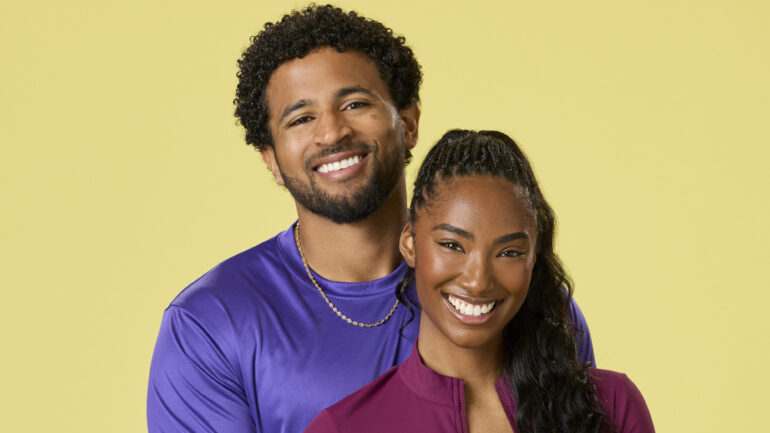Exclusive Interview
Inside Lyla Sage’s Rebel Blue Finale ‘Wild & Wrangled’ and Her Next Chapter

If you aren’t into cowboys, let Lyla Sage convince you. She’s the author behind the uber-successful Rebel Blue Ranch series that kicked off with Done and Dusted in 2023. With all its small-town goodness and local gentlemanly cowboys that are almost impossible not to fall for, Sage is sending the Rebel Blue series off with the fourth and final installment of the series, Wild and Wrangled, out now.
Cam is about to walk down the aisle at the start of Sage’s series conclusion, but she is stood up at her own wedding and ends up finding comfort in the one person she knows she shouldn’t: her childhood love and ex-boyfriend, Dusty. While trying to reshape her life into her own, Dusty keeps appearing at every turn, and it’s becoming more difficult for Cam to resist the feelings she feels rekindling for him. But Cam remembers their big blowout breakup from years ago, and the dust still hasn’t settled on the cracks formed in their relationship. Can Cam stop looking back, or is a second chance what she’s been waiting for all along?
Sage breaks down the nuance behind the modern day cowboy romance novel, her penchant for writing slow burns, expanding the friendships between her heroines, and what makes all her love interests so damn swoonworthy.
How are you feeling about sending the Rebel Blue series off?
Lyla Sage: I think there’s a mix of emotions here. I’m very deeply attached to Rebel Blue. When I started with it, it was all I had. It was a place where I went to find comfort and safety. And it’s been such a joy to welcome other people there, too. But also, I’ve been there for two years of my life. It’s been a really beautiful thing to leave and look back, and also have something new on the horizon. So I feel like I’m in this perfect in-between right now, where I haven’t had to say goodbye yet. But I’m also working on something new, where Meadowlark exists in the same universe that I’m creating, so I am not leaving it behind forever. But it is really refreshing to say goodbye. I’m simultaneously so deeply proud of what I accomplished at Rebel Blue, and I also know that everything I do will always be influenced by who I became during this two-year period. But it’s also really nice to leave the town for a little bit and maybe come back later.
Had you always known Cam and Dusty would be the final couple of the series?
Sage: I really wanted to bookend the series with two people who found their home at Rebel Blue, who weren’t necessarily part of the nuclear family. [The series starts] with Luke Brooks and Done and Dusted, who the entire series is built off him. His back probably hurts from carrying this whole thing because he was the first character I conceptualized. And then I wanted to end with Cam, who obviously finds her home with the Ryders and is a different daughter to them and who has found her family that way. I knew I didn’t want to end it with a Ryder family member. I wanted to kind of bring that idea home, that Rebel Blue isn’t just for them, it’s for all of us.
Cowboys have always been a staple of the romance genre but have recently become far more popular in the zeitgeist. Why do you think that is?
Sage: There’s always going to be something romantic about the Wild West, right? The vision we’ve been provided of the Wild West is always going to be kind of romantic. You’ve got wide open spaces. If we’re talking about a cis romance, you’ve got a rugged cowboy who really sweeps the heroine off her feet. There’s something romantic and idealized about that, and there’s a reason why we’ve been telling stories about cowboys since 1850. It’s because we really like that sort of narrative. I think in the last couple of years, it hasn’t just been a romance thing. We see boot brands like Lou Casey and Tecovas making it mainstream, and all of a sudden it’s something that people are wearing wherever they’re at. So it’s been influenced in fashion. It’s been influenced in literature, in television, with Yellowstone and American Primeval. You’ve just seen a resurgence.
And it’s layered because I think we’ve also seen a resurgence in some conservative ideology, and sometimes cowboys and Westerns can be equated with conservatism. That’s not my experience. That’s not how I grew up. But I would be remiss to say that I didn’t also think that that might be part of the reason that cowboys have come riding back. But it’s been really exciting to watch this resurgence of Western romances because I loved reading them. The first western I read was by Lorraine Heath, who’s a historical romance author. I didn’t even read them in order. But I just remember being really drawn to the covers, and then I got into Beverly Jenkins, who I feel like there’s a knowledge gap [around her] some romance writers talk about how they don’t know who Beverly Jenkins is. It’s just been so fun for me to hopefully infuse yearning and small moments in my Western romances, which are very much contemporary. It’s just exciting to have the chance to broaden a genre. That’s what we get to do when we have these trends come and go. Hopefully we get to broaden the space. But there are other people out there who have been writing Western romances for years who don’t look like me. If my Western romance is hitting a moment, it gives me the ability to broaden the horizon there for everyone. I think that’s a really special gift.
Small town romances are embedded with history and lore. How did you want to use the small town trope to your advantage with Cam and Dusty’s dynamic?
Sage: Small towns have lore, history, and extremely long memories. That was something I really wanted to play around with Dusty and Cam, where the Ryders are so desperate to push her a little bit, but they refrain, thank goodness. One thing that’s always on Cam’s mind is other people. For Dusty, he’s able to march to the beat of his own drum. His personality is just different that way. But for Cam, what other people think of her is desperately important, and it was just really fun to explore how she was going to find her footing in this new town with an old boyfriend. It was a joy. I wrote flashbacks for the first time. I wrote one singular flashback in my third book, [Lost and Lassoed], and this one has multiple. Not only is it fun to explore Dusty and Cam’s relationship through those flashbacks, but it’s also fun to see what Meadowlark was like. We get to explore places that don’t exist in the Rebel Blue universe yet, like Meadowlark High School.
We know that Wes Ryder is the same age as Dusty and Cam, and we get to begin to see all of these crossovers. Meadowlark itself is this tangled web in my head. Everybody is somehow connected to everybody. History in small towns is something that I love, and it is something that I had so much fun doing in Rebel Blue that I’ve taken it to my next series, really next level. There’s no better mind exercise than history in a town, but specifically in small towns. I think even if you don’t see it on the page, it’s informed by the way that I’ve chosen to write and tell the story.
Cam struggles with her family have left her with the mindset that love should be earned. How does that mentality play out as she’s rekindling with Dusty?
Sage: It was really important to me to show this part of Cam on the page. I do think readers are less inclined to give grace to more complicated femme characters. I’m very protective of Cam. I’m very protective of Cam and Ada [from Swift and Saddled], because those two are a little bit messier than my other two femme characters, so they don’t get as much grace. But for Cam to understand why Dusty is perfect for her, you have to understand where she came from, where she grew up. I think also her being able to coparent Riley comes from a desperation to not be like her parents. I think it’s easy to read about parents who think that you need to earn love in a novel, but I wanted to try and show what kind of effect that has on a person. Even though Cam is encroaching on 31, the things that happened to her when she was 13 through 19 are always going to inform her relationships.
This is also a first for me. All of my parents in Rebel Blue so far have been present and loving and accepting, so it was different. I had a hard time putting these things on a page that have so negatively impacted Cam that we see her consistently, in a state of fight or flight for her entire life, up until she meets Dusty and finally has a soft place to land. It was hard to do, but it was necessary to her character and her journey, and I’m really proud of her. That’s what I want to feel at the end of every book. Not necessarily proud of the book—I want that—but I want to feel proud of my characters and their journey and ending up in a place that feels good for them.
I’ve always found that second chance romances are the most difficult to pull off. In writing a second chance romance, what did you find to be the most challenging aspect about writing their adult dynamic versus writing their younger dynamic?
Sage: The first thing to say is I don’t generally like second chance romances. I have a few exceptions to the rule. I love The Ex Vows by Jessica Joyce and When I Think of You by Myah Ariel. I think they’re sweeping and magnificent and wonderful. But in general, I have a hard time because I’m always like, well, that’s stupid, or it’s not forgivable. That’s another reason why I saved them for last is because if you look at my writing, [particularly] Done and Dusted and Wild and Wrangled, I think there’s very hopeful growth and change there. And I wanted to have more practice just writing books for consumption before I tried to write this trope that I don’t always believe in. But I believe in these two and I think the reason why is because it’s less a matter of what somebody did and more a matter of timing. I wanted to show that sometimes we’re just not equipped for what comes our way. I think it’s reasonable for two 18 year olds to not quite be equipped for this type of big love that they have been blessed with for that time period in their lives. It felt extremely realistic to me that these two had to grow up and do their own thing before they could fall back together. I call it a soft second chance or second chance lite. Because, yes, they were together. Yes, they broke up, but there’s there’s no real barrier for the two of them except for themselves.
I’d call this book a slow burn. What do you enjoy about making the reader wait? How do you build up anticipation for the Big Moment?
Sage: I don’t purposely write a slow burn every time, but I accidentally do every single time, and I think it maybe has to do with the way that I write and my setup. All of a sudden, I’m at 30,000 words, and they haven’t kissed yet, and I’m like, oh my god, what have we done? But for these two, it was more intentional, and it is intentional. Because I want to lay a firm foundation of comfort. Because I find that when I shift gears from kissing to the bedroom, I love having a foundation of comfort because I think it creates a better sense of intimacy between the characters, especially two characters like this, who have history. I wanted to take as much care as possible, and make sure that every part of this story felt right for them. Also, something I’m really passionate about in romance novels, and in general, is nice men. I want to be able to write men that showcase the fact that they aren’t just nice and respectful to the girl they think is hot. Because that’s not actually a nice man. I want to showcase that these men are careful and kind and soft.
You mentioned your extra care for Ada and Cam. How did you land on the friendship we see between those two characters? How do you know which characters feel like they’ll connect on a deeper level?
Sage: I think of Rebel Blue Ranch as a sitcom while I’m writing it. I want to make sure that some people who are familiar are coming through the kitchen and then they’re leaving. They’re not stealing the show, but they’re there, and they exist. Because this is a family. But for Cam and Ada, they just fell together naturally. Their friendship wasn’t a huge consideration for me when I started writing Swift and Saddled, and then Cam appeared, and I was like, these girls are very different, but I think they have some similarities in their heart.
I also was playing around with Ada specifically, and this led into Cam, this idea of a pick me girl because I think we’ve lost the plot on what that means. I wanted to write a girl like Ada who people would not think is a girl’s girl, and as such, be labeled a pick me girl, even though she’s the antithesis of what a pick me girl is. That’s where Ada’s character development came from, so I was looking for a very specific type of friendship for her. Somebody who would be comfortable standing on the outside, especially because Ada is quite introverted, as is Cam. These two have so much hurt wrapped into their versions of love that I just wanted two people who could sit on the outside together. They felt so right together. Not every friendship is going to be loud, like Emmy and Teddy. Not every friendship is going to be that thing that you’ve had since you were a kid that is just part of your genetic makeup. It’s not going to be loud and boisterous, and it’s just not going to be that way. And so it was fun for me to write about a softer friendship between these two women who saw bits of themselves in each other, and because of that, learn to be proud of themselves.






